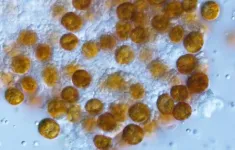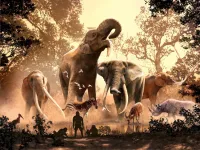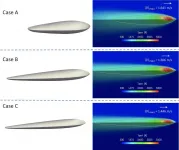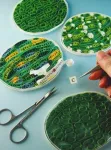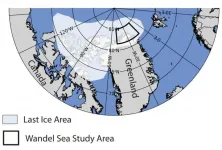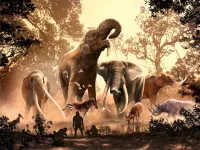Rewiring the adult brain — Scanning the mind of a blind 'Batman' reveals that novel maps can emerge in the adult brain
Research reveals a new form of brain plasticity -- formation of 'topographic maps' in the wake of an unusual sensory experience
2021-07-01
(Press-News.org) The adult brain is more malleable than previously thought, according to researchers from the Interdisciplinary Center Herzliya. They trained a 50-year-old man, blind from birth, to "see" by ear, and found that neural circuits in his brain formed so-called topographic maps - a type of brain organization previously thought to emerge only in infancy. This finding reported recently in END
ELSE PRESS RELEASES FROM THIS DATE:
Newly discovered genetic variants in a single gene cause neurodevelopmental disorder
2021-07-01
Rochester, Minn. -- Mayo Clinic researchers have discovered that genetic variants in a neuro-associated gene called SPTBN1 are responsible for causing a neurodevelopmental disorder. The study, published in Nature Genetics, is a first step in finding a potential therapeutic strategy for this disorder, and it increases the number of genes known to be associated with conditions that affect how the brain functions.
"The gene can now be included in genetic testing for people suspected of having a neurodevelopmental disorder, which may end the diagnostic odyssey these people and their families have endured," says Margot Cousin, Ph.D., a translational ...
Scientists resurrect 'forgotten' genus of algae living in marine animals
2021-07-01
UNIVERSITY PARK, Pa. -- In the late 1800s, scientists were stumped by the "yellow cells" they were observing within the tissues of certain temperate marine animals, including sea anemones, corals and jellyfish. Were these cells part of the animal or separate organisms? If separate, were they parasites or did they confer a benefit to the host?
In a paper published in the journal Nature in 1882, biologist Sir Patrick Geddes of Edinburgh University proffered that not only were these cells distinct entities, but they were also beneficial to the animals in which they lived. He assigned them to a new genus, Philozoon -- from the Greek phileo, meaning 'to love ...
For women workers in India, direct deposit is 'digital empowerment'
2021-07-01
Giving women in India's Madhya Pradesh state greater digital control over their wages encouraged them to enter the labor force and liberalized their beliefs about working women, concluded a new study co-authored by Yale economists Rohini Pande and Charity Troyer Moore.
The study, published in the American Economic Review, found that a relatively simple intervention directed to poor women -- providing them access to their own bank accounts and direct deposit for their earnings from a federal workfare program, along with basic training on how to use local bank kiosks -- increased the amount ...
The rise and fall of elephants
2021-07-01
Based on fossil finds, we know that the vast majority of species that once inhabited the earth have become extinct. For example, there are about 5,500 mammal species living on the planet today, but we know of at least 160,000 fossil species, so for every mammal species living today, there are at least 30 extinct ones. We therefore know with great certainty that the lineages of living things come and go along immense time scales. But what factors cause these lineages to come into being and disappear is still an unsolved question.
To investigate ...
Using AI to predict 3D printing processes
2021-07-01
Additive manufacturing has the potential to allow one to create parts or products on demand in manufacturing, automotive engineering, and even in outer space. However, it's a challenge to know in advance how a 3D printed object will perform, now and in the future.
Physical experiments -- especially for metal additive manufacturing (AM) -- are slow and costly. Even modeling these systems computationally is expensive and time-consuming.
"The problem is multi-phase and involves gas, liquids, solids, and phase transitions between them," said University of Illinois Ph.D. student Qiming ...
Mefloquine: A promising drug 'soldier' in the battle against COVID-19
2021-07-01
Early 2020 saw the world break into what has been described as a "war-like situation": a pandemic, caused by the severe acute respiratory syndrome-related coronavirus 2 (SARS-CoV-2), the likes of which majority of the living generations across most of the planet have not ever seen. This pandemic has downed economies and resulted in hundreds of thousands of deaths. At the dawn of 2021, vaccines have been deployed, but before populations can be sufficiently vaccinated, effective treatments remain the need of the hour.
Thus, other than fast-tracking research into novel drugs, scientists have also been exploring their ...
New approach can add diversity to crop species without breeding GMOs
2021-07-01
Breeding better crops through genetic engineering has been possible for decades, but the use of genetically modified plants has been limited by technical challenges and popular controversies. A new approach potentially solves both of those problems by modifying the energy-producing parts of plant cells and then removing the DNA editing tool so it cannot be inherited by future seeds. The technique was recently demonstrated through proof-of-concept experiments published in the journal Nature Plants by geneticists at the University of Tokyo.
"Now we've got a way to modify chloroplast genes specifically and measure their potential to make a good plant," said Associate Professor Shin-ichi ...
How children integrate information
2021-07-01
"We know that children use a lot of different information sources in their social environment, including their own knowledge, to learn new words. But the picture that emerges from the existing research is that children have a bag of tricks that they can use", says Manuel Bohn, a researcher at the Max Planck Institute for Evolutionary Anthropology.
For example, if you show a child an object they already know - say a cup - as well as an object they have never seen before, the child will usually think that a word they never heard before belongs with the new object. Why? Children use information ...
Last ice-covered parts of summertime Arctic Ocean vulnerable to climate change
2021-07-01
In a rapidly changing Arctic, one area might serve as a refuge - a place that could continue to harbor ice-dependent species when conditions in nearby areas become inhospitable. This region north of Greenland and the islands of the Canadian Arctic Archipelago has been termed the Last Ice Area. But research led by the University of Washington suggests that parts of this area are already showing a decline in summer sea ice.
Last August, sea ice north of Greenland showed its vulnerability to the long-term effects of climate change, according to a study published July 1 in the open-access journal Communications Earth & Environment.
"Current thinking is that this area may be the last refuge for ice-dependent ...
Global climate dynamics drove the decline of mastodonts and elephants, new study suggests
2021-07-01
Elephants and their forebears were pushed into wipeout by waves of extreme global environmental change, rather than overhunting by early humans, according to new research.
The study, published today in Nature Ecology & Evolution, challenges claims that early human hunters slaughtered prehistoric elephants, mammoths and mastodonts to extinction over millennia. Instead, its findings indicate the extinction of the last mammoths and mastodonts at the end of the last Ice Age marked the end of progressive climate-driven global decline among elephants over millions of years.
Although elephants today are restricted to just three endangered species in the African and Asian tropics, these are survivors of a once far more diverse and widespread group of giant herbivores, known ...
LAST 30 PRESS RELEASES:
World-first discovery uncovers how glioblastoma tumours dodge chemotherapy, potentially opening the door to new treatments
A fatal mix-up: How certain gut bacteria drive multiple sclerosis
New AI tool identifies not just genetic mutations, but the diseases they may cause
Deep-learning model predicts how fruit flies form, cell by cell
Combination pills for high blood pressure may simplify treatment, improve long-term health
Immune system keeps mucosal fungi in check
Neurons within the brain use simple rules to localize genetic messages
Electrodes created using light
Second-hand gift-giving is a well-deliberated decision
How human interaction drove evolution to make bears less aggressive
National Poll: Few parents offer teens guidance on healthy eating during holiday season
Cannabis derivatives could provide new ovarian cancer treatments
Raising strong yeast as a petroleum substitute
Clues to the origin of hot Jupiters hidden in their orbits
Canada’s reduced pledge to Global Fund will impact domestic health
1 in 4 children with major traumatic injuries not cared for in pediatric trauma centres
Duke and Duke-NUS’ joint cross-population research to uncover "East-West" differences in disease and care
Scientists to ‘spy’ on cancer- immune cell interactions using quantum technology breakthrough
Tech savvy users have most digital concerns
Making lighter work of calculating fluid and heat flow
Normalizing blood sugar can halve heart attack risk
Lowering blood sugar cuts heart attack risk in people with prediabetes
Study links genetic variants to risk of blinding eye disease in premature infants
Non-opioid ‘pain sponge’ therapy halts cartilage degeneration and relieves chronic pain
AI can pick up cultural values by mimicking how kids learn
China’s ecological redlines offer fast track to 30 x 30 global conservation goal
Invisible indoor threats: emerging household contaminants and their growing risks to human health
Adding antibody treatment to chemo boosts outcomes for children with rare cancer
Germline pathogenic variants among women without a history of breast cancer
Tanning beds triple melanoma risk, potentially causing broad DNA damage
[Press-News.org] Rewiring the adult brain — Scanning the mind of a blind 'Batman' reveals that novel maps can emerge in the adult brainResearch reveals a new form of brain plasticity -- formation of 'topographic maps' in the wake of an unusual sensory experience

